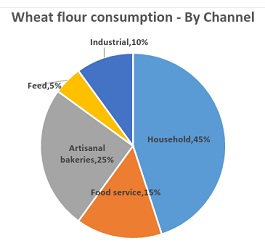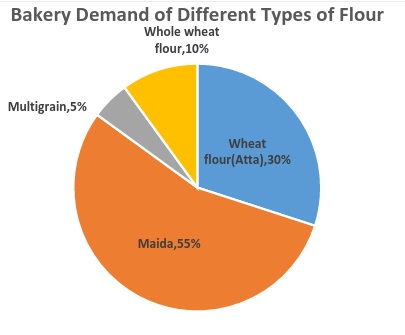|
|
|
You can get e-magazine links on WhatsApp. Click here
|
|
|
|
|
|
Growing health awareness driving rise of maida alternatives like atta
|
|
Thursday, 17 November, 2016, 08 : 00 AM [IST]
|
|
Abinaya Gunasekaran
|
|
fiogf49gjkf0d fiogf49gjkf0d Bakery market in India
The Indian bakery market was valued at Rs 450 billion (~US$6.8 billion) in 2015. Bakery is the largest segment of the food processed industry in India which accounted for 6 million tonne of baked goods manufactured in 2015. Bread and biscuits are the two major segments of bakery, which account for about 85% of total bakery products. About 65% of all baked goods produced in industrial conditions are highly organised. Remainder of the baked foods are manufactured by small-scale and artisanal units, including food service units that bake and sell their own food.
Market leaders in the bakery sector are Britannia, Parle, ITC, Mondelez and Unibic. Bakery sector in India is forecast to grow at a CAGR of 7.7% per annum during 2015-2020.
Ready-to-eat baked foods such as breads are consumed in the form of sandwich for breakfast. Lifestyle changes and eating habits are largely driven by the growing urbanisation and rising working women population.
Wheat flour consumption
 It is observed that 80% of whole wheat flour is milled by unorganised small chakki mills and remaining 20% by organised mills, which makes the estimation of the size and capacity of the milling industry difficult. The organised flour mills are however growing to meet the increasing demand from the industrial end-users. Minimal changes have been observed in the wheat flour consumption in India over the past few years. Domestic wheat flour consumption is largely in the form of homemade flat breads (which are called roti or chapati in India), that are prepared with custom milled whole wheat flour (atta). The use of branded packaged atta, marketed by large companies, is increasing in cities but is only preferred by upper income families. It is observed that 80% of whole wheat flour is milled by unorganised small chakki mills and remaining 20% by organised mills, which makes the estimation of the size and capacity of the milling industry difficult. The organised flour mills are however growing to meet the increasing demand from the industrial end-users. Minimal changes have been observed in the wheat flour consumption in India over the past few years. Domestic wheat flour consumption is largely in the form of homemade flat breads (which are called roti or chapati in India), that are prepared with custom milled whole wheat flour (atta). The use of branded packaged atta, marketed by large companies, is increasing in cities but is only preferred by upper income families.
Use of Maida Flour
 Maida is super refined flour obtained from wheat. After the separation of bran from the wheat grain, it is passed through sieve generally of 80 mesh type to refine the endosperm. The resulting flour is called as maida which is naturally yellowish due to pigments present in wheat. It is then bleached either naturally due to atmospheric oxygen or using chemical bleaching agents such as Benzoyl peroxide, Calcium peroxide, Chlorine gas, NO2, Chlorine dioxide and Azodicarbonamide. The most commonly used bleaching agents are Benzoyl oxide and Chlorine gas.
Maida is super refined flour obtained from wheat. After the separation of bran from the wheat grain, it is passed through sieve generally of 80 mesh type to refine the endosperm. The resulting flour is called as maida which is naturally yellowish due to pigments present in wheat. It is then bleached either naturally due to atmospheric oxygen or using chemical bleaching agents such as Benzoyl peroxide, Calcium peroxide, Chlorine gas, NO2, Chlorine dioxide and Azodicarbonamide. The most commonly used bleaching agents are Benzoyl oxide and Chlorine gas.
Traditionally maida has been used as a primary ingredient of bakery sector in India. Maida remains as an integral ingredient in making Indian breads such as naan, parathas and also has number of other applications in processed foods, such as thickening sauces, coating fried foods, and dusting pans for baking cakes. In households of India, maida is used as a main ingredient in making eggless sponge cake, roti, naan, nacho chips, pizza base, vegetable patties, bhatura, jalebi, and tacos. Small quantities of maida is being added in the recipe of the following food items such as rasgulla, corn balls, vegetable cutlets, gulab jamun, spring rolls, rasamalai to modify the rheology, texture and coating of products.
Maida is similar to cake flours sold in the Western countries including USA, with protein content lower than the all purpose flour. It is not only used in India but also in Central Asia and South Asian countries.
Alternatives to Maida
Why there is a need for an alternative to maida? Rising health awareness among the consumers drives the manufacturers to look for alternative flours. Several maida processors follow chemical bleaching method, in which chlorine gas is employed and leads to formation of a by-product called alloxan in the bleached flour. Based on various clinical studies, it is shown that alloxan may induce diabetes by selectively destroying insulin producing beta cells in the pancreas. Hence, bleaching of wheat flour with alloxan and potassium bromate (carcinogen) has been banned by FSSAI in the recent period.
Atta (wheat flour without bran) and whole wheat flour is considered to be an alternative for maida by the baked food processors. Whole wheat flour is used in making breads and other baked foods. It is perceived as healthier flour than maida as it has bran, fibre, vitamins, minerals and other nutrients. Packaged atta market is dominated by ITC with its brand Aashirvaad which holds nearly 30% share followed by other players such as Shakti Bhog, Annapurna and Pillsbury. Packaged atta market is anticipated to grow at a CAGR of 15% for the next three years.
Currently, the price of whole wheat flour and maida is Rs 45-50/kg and Rs 20-25/kg respectively. Consumer preference is shifting from maida to whole wheat flour considering its higher bran and fibre content, despite its higher price.
Shortening and its alternatives
Shortening is any fat used to make pastries (crumbly structure) and other food products. The purpose of the ingredient is to shorten gluten strands. Traditionally, hydrogenated vegetable oils are used as shortening in baked foods. Fat content of shortening is 100%, whereas butter/margarine/lard has less than 85%.
Vegetable shortenings are manufactured from partially hydrogenated vegetable oils, so the presence of trans fats has become a health issue. Hence, margarine and butter has been used to replace shortening in baked foods. Amul, Britannia and Zydus Wellness are the key players in margarine market. Zydus has about 50% volume share in the market. The size of margarine market in India was valued at Rs 2 billion, whereas the butter market was valued at Rs 13.5 billion. The margarine market is expected to grow at a CAGR of 7.5% for the next four years. The above growth rate shows a good sign that consumers are shifting towards healthier fat ingredients.
At this junction of health and wellness, consumer awareness and initiatives from regulatory bodies and manufacturers plays a key role in choosing healthier alternative ingredients, such as whole wheat and multigrain breads over conventional maida breads and margarine over traditional shortenings.
(The author is food technologist. She can be contacted at abinaya@giract.com)
|
|
|
|
|
|
|
|
|
|